Struggling to get your pitches noticed? Crafting a solid media list is key to getting your story in front of the right journalists. This handy guide will show you how to research, organize, and update your press list so that you’ll land home-run coverage every time.
What is a Media List?
A media list is a document or database that contains information about the journalists, bloggers, and influencers who cover stories relevant to your niche.
A media list is made up of three key components.
Contact information: It goes without saying you’ll need a journalist’s contact info to be able to pitch them!
Journalist details: Your media list should be a place you record key journalist information, e.g. their beat or vertical. Details like this will give you a deeper understanding of your contacts, so you can build genuine relationships and up the ante on pitch personalization.
Outreach planning: Your media list is also a place to organize, prioritize, and schedule your outreach. The better you document your pitching process, the more likely you are to win the right kind of coverage.
What Does a Media List Include?
A media list shouldn’t just be a directory of journalist names and contact details. You can take that approach… if you want to stay firmly on read.
Instead, your seeding lists should be the result of deep research into who a journalist is, and how they operate.
💡Key Components of a Media List:
- Contact details (predominantly their email address)
- Full name
- Outlets (many journalists write for multiple publications)
- Role (e.g. journalist, reporter, data journalist etc.)
- Beats and topics covered (e.g. nutrition, Crossfit, paleo etc.)
- Social media handles
- Relevant past content
What Makes For An Effective Media List?
So, we've been through the key criteria to include in a media list, but what else? Quite simply, your media list is only as good as the coverage it's able to generate.
According to our State of the Media report, only 7% of journalists say the pitches they get are relevant to their audience.
Pitch personalization is key.
The more you can get to know the journalists in your media lists, the more you can tailor your campaign and pitch toward them.
To do that, try adding extra criteria to your press seeding list...
💡 Extra Media List Criteria:
- Fresh contact details so you're not pitching empty inboxes.
- Recent articles to know what a journalist is writing about right now, and even mirror in your subject lines.
- Most popular articles to reference in your pitch. If you offer to help a journalist repeat their past success, you're far more likely to win the pitch (i.e. “I noticed your most engaging article to date was on the topic of X. I have brand new data on the topic of X which could be of interest to your audience.”).
- Frequency/publishing cadence so you have an idea of a journalist's coverage turnaround and can manage team or client expectations.
- Journalist performance metrics, such as potential audience reach, so you can prioritize the most engaging journalists in your outreach.
- Publication performance metrics, such as domain authority (DA), so you can prioritize the most engaging outlets in your outreach.
- Content style The content format and headline styles your journalist commonly embraces e.g. studies, interviews, localized content. Knowing this information means you can replicate it in your campaign and subject line.
- Emotions evoked The kinds of emotions a journalist’s articles evoke in their audience (e.g. anger, amusement, love etc. This can help you with your pitch angle and subject line).
- Pitch preferences Whether they have a preference towards email vs DMs (journalists sometimes share this info via a social post or bios).
- Location If you're pitching across locations, make note of where you journalist is based (e.g. country, state, city, etc).
- Syndication Include a journalist's or publication's ability to syndicate a story, if this is something you or your client are hoping to achieve.
- Local time If you're pitching for international press, make note of local times so you time your email pitches appropriately (e.g. EDT, GMT, etc.).
- Languages spoken If pitching globally and hoping to get your coverage translated, make a note of the languages a journalist writes in.
- Notes Add anything else that would be relevant to know for personalizing your pitch (e.g. a reporter's interests, opinions, political leaning, style of referencing, existing relationships with your team etc.).
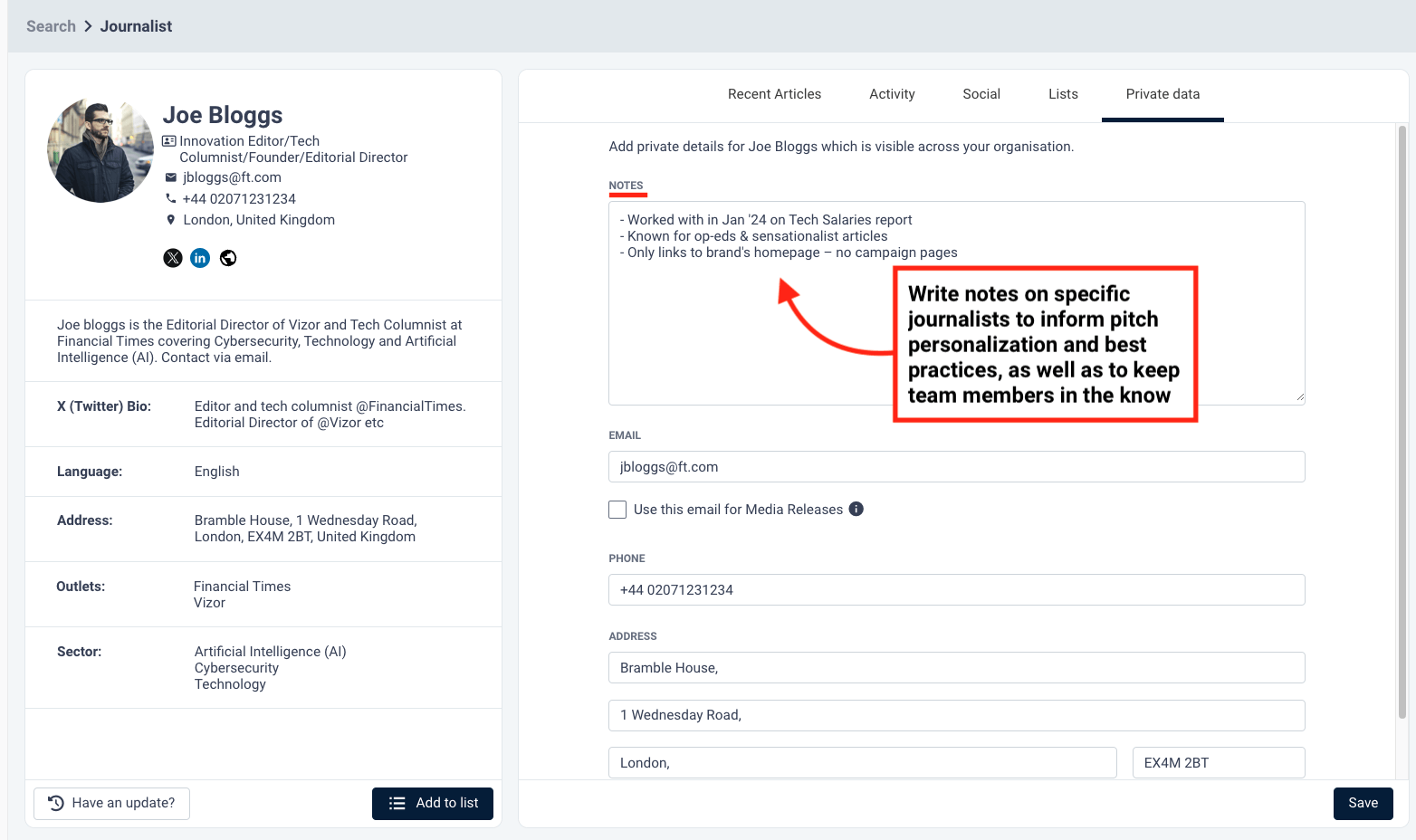
A view of media list contact in CisionOne’s database, showing a notes section where PR pros can write information to assist with outreach.
Digital PR Expert and Freelance Consultant, Jo O'Reilly, regularly includes language information in her media lists:
"If it's a global campaign, i will leave a little note for myself whether a release needs to be sent in American or British English."
We surveyed three thousand journalists to find out:
How they want to be pitched
Their top metrics
Their biggest challenges
And more. To get inside the minds of journalists while you're creating your PR media list, download our full State of the Media report.

What Are the Different Types of Media Lists?
Generally speaking, there are four different types of media list:
1. Master Media List
These are the people you’re invested in building close working relationships with over time. PR pros are always updating and referring back to this media contact list. As a result, it's incredibly detailed. Your closest contacts go in here, along with other journalists you have the potential to generate repeat coverage from (e.g. reporters who cover seasonal content).
A central rolodex like this is especially important if you’re doing consistent PR for the same brand/group of brands (e.g. in-house). If you intend to pitch the same contacts on an ongoing basis, you want to pull as much information as you can into this core list.
2. Press Release Media List
A wider list of industry-specific journalists who are most likely to cover your business news. You may not be as close to these contacts, but they should still be relevant to your story. Journalists whose articles regularly get syndicated are a good option to include in this type of media list.
3. Campaign Media List
A press list you build from scratch for a one-off campaign. You can be a bit more selective with the criteria of this type of media contact list, so that it aligns with your campaign-specific goals. Be sure to only include hyper-relevant journalists who will get value out of covering your story. You can add contacts from other, existing media lists, but only if they help you achieve the campaign’s end goal.
4. Reactive Media List
Finally, you have your reactive media list. You pull this type of media list together when you're newsjacking trending topics. Given the tight turnaround, it will be less thorough than your other lists. Personalization is always important, but with reactive PR, the story tends to speak for itself. That's why it's ok for your reactive media list to be brief and contain mostly core information.
There can, of course, be crossover between all four press list types.
3 Media List Examples
Media List Template Example 1: Cision Google Sheet
If you want to build your media list in a spreadsheet format, we’ve put together a campaign media list template to help you dive straight in. Get tips on the criteria that will help you build a successful seeding list – from journalist details to outreach tracking.
Get Cision’s media list template
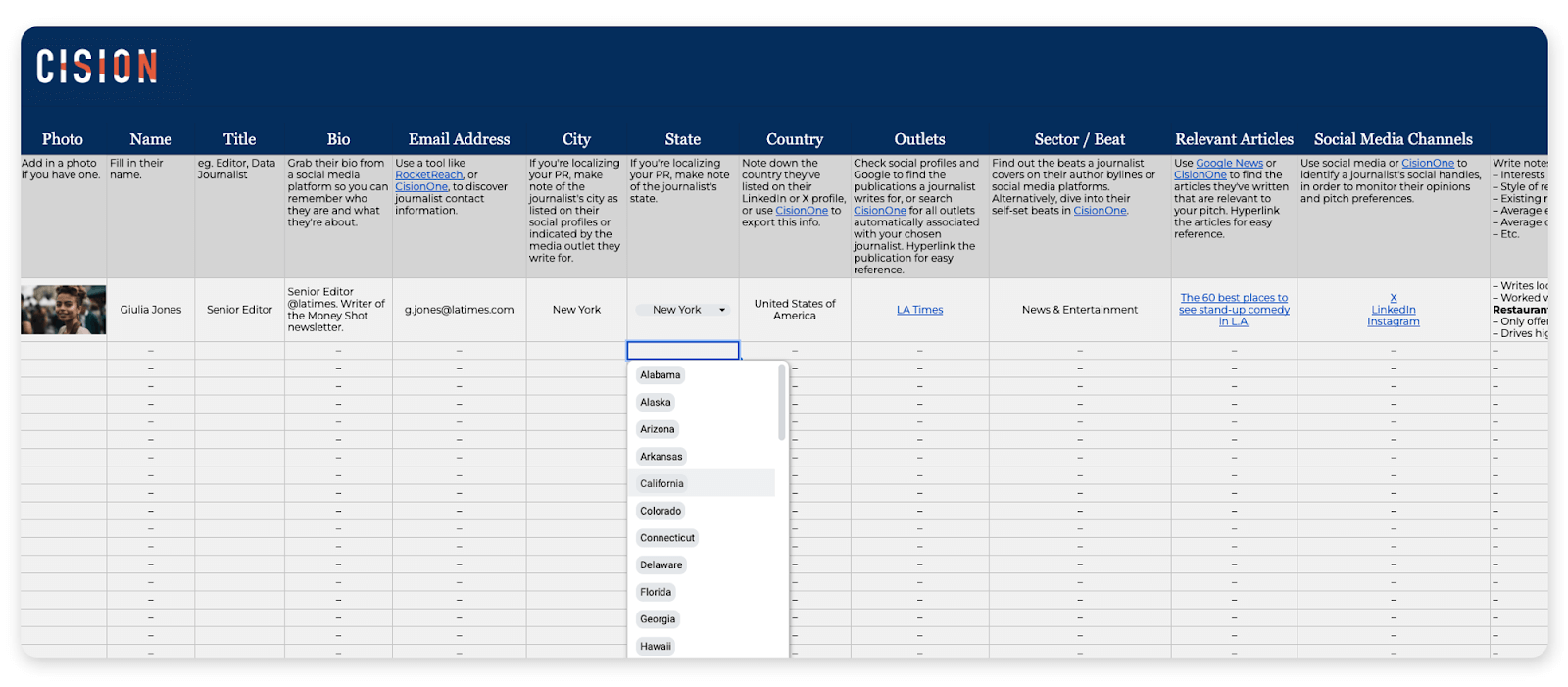
Media List Template Example 2: Olivia Lott PR Google Sheet
Expert PR consultant, Olivia Lott, builds her campaign using Google Sheets. Download the media contact list template to find out why she includes certain criteria and get some sage advice for your next PR list.
Get Olivia’s template
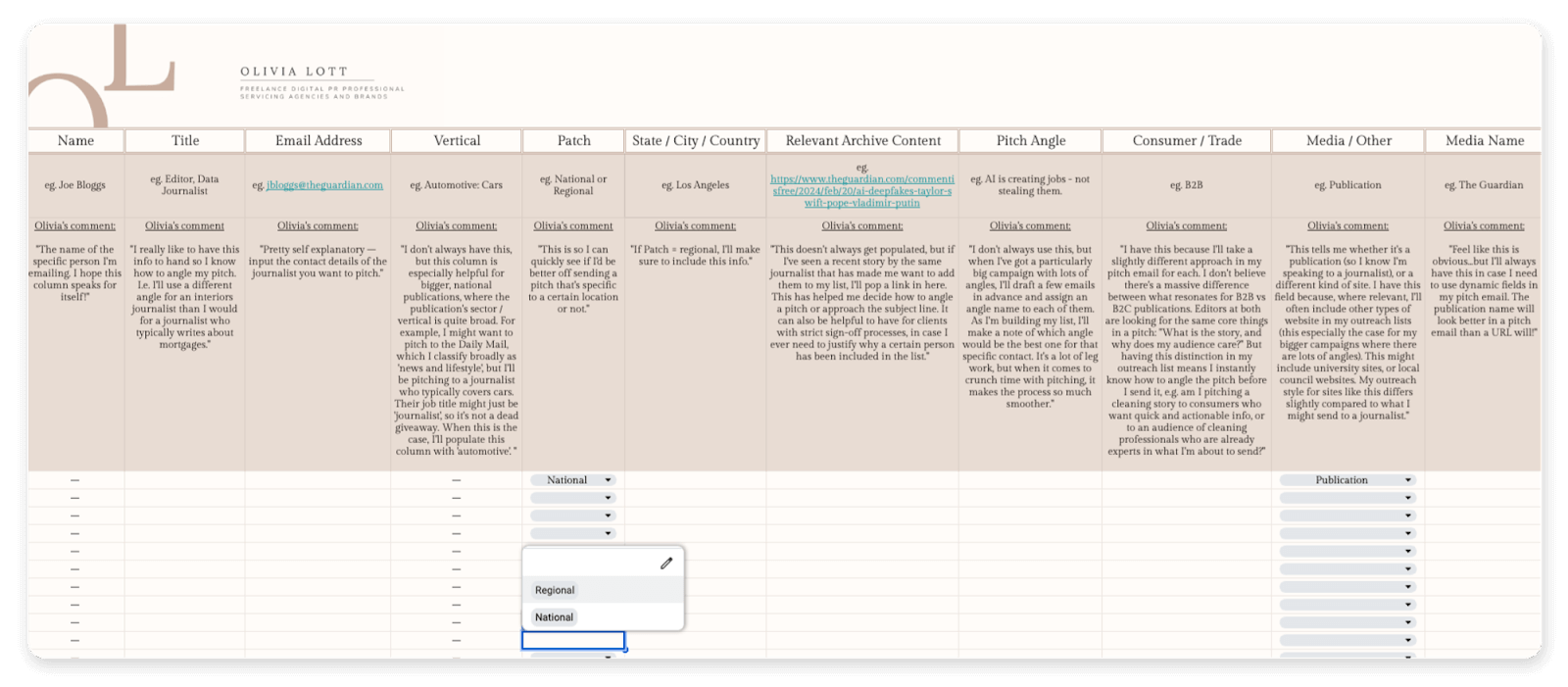
"Not every single outreach project I work on will have a media list as detailed as this. Sometimes I've got to act much faster, in which case I'll only pull core info (name, email, publication) and go for it. But having detailed lists, especially for big campaigns, has helped me enormously with staying organized (and means I can easily find what I need later down the line when I start working on a new campaign)."
Olivia Lott, PR Expert, Freelance Consultant, and former Journalist
Media List Template Example 3: Airtable
If you want to work collaboratively on your media lists, setting up an Airtable document is a great way to go. Airtable already feature a media list template in their template library, so save time tweaking the layout, and focus on enriching the information you include in your list, based on your campaign goals.
Get the Airtable template
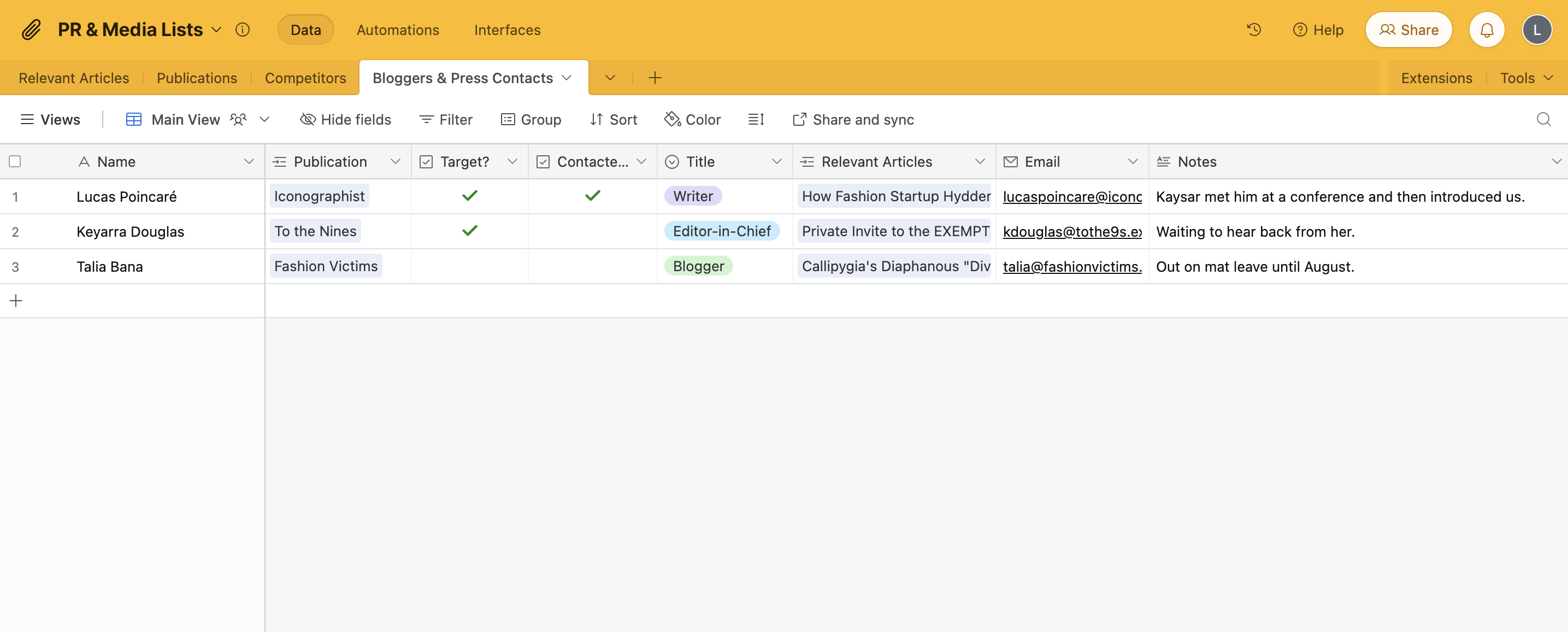
Expert PR Advice on Building Media Lists
Get advice from on-the-ground PRs on what to include in your next press list.
Laura Mallison
"When it comes to building a reactive media list for newsjacking, commentary distribution, or sending a trend-led pitch, relevancy is crucial. Not only do you need to ensure the journalistic contact is going to be interested in the pitch (like with all good media lists), but you want to ensure it's something they'll want to cover now while the news is hot. This is why ensuring you keep your contact database up to date with journalist's job titles, beats or topics of interest is crucial, along with any leave updates like maternity/paternity leave or sabbatical breaks, because the newscycle will have moved on by the time they do eventually get to your email! For breaking news or reactive pitches, I also like to check for journalists talking about the topic on social media platforms, like X or Threads, as this will confirm their interest in the topic and give you an opportunity to add their own personal hot take on the breaking news to your pitch email! If you're going out with a global pitch, or a story that covers multiple time zones, it's also important to note the journalist's country and time zone when building your media list. This will help you send your pitch at an optimal time and not land in their inbox in the dead of night just to get stuck underneath the influx of morning emails the next day. It will also help you to customise your campaign pitch for different markets, perhaps changing the grammar conventions for that country's press or pulling out specific key data points for that market - by identifying the specific markets and locations at the media list building time, you make it easy to action these valuable personalisation stages when outreaching."
Laura Mallinson, Digital PR Manager at Seeker Digital
*
Tayla Davie
“At NORTH we use Google Sheets to create media lists and will always include the name of the media outlet, the journalist/contact name, job title, email address and any additional notes or comments that will help support a personalized pitch. We also split media lists by topics covered, which usually helps us to tailor a pitch appropriately. There are a few key things to consider when building a media list, from relevancy, responsiveness, and recent engagement, to existing relationships.”
Tayla Davie, Digital PR Manager, NORTH
*
Katy Powell
PR expert Katy Powell takes the following steps when building her journalist lists:
- Reviews past media lists to find relevant journalists and checks they're still active.
- Reuses core/evergreen media lists (featuring journalists she has already established a relationship with) for yearly or seasonal PR (– e.g. gift guides).
- Builds media lists from scratch for unique campaign ideas, to account for industry shifts and journalist personnel changes.
- Leaves article notes on her media list, detailing specific content that the journalist has written, to demonstrate their relevance for pitching.
Katy Powell, Digital PR Director, Bottled Imagination
*
Tom Chivers
"When I build a seeding list, I create a different list for each campaign as, what might be relevant to one journalist in one campaign, may not cover their beat in another – eg. you're representing a personal finance brand and talking about recession figures one day, to housing prices the next. When creating a seeding list I tend to collect the following info…
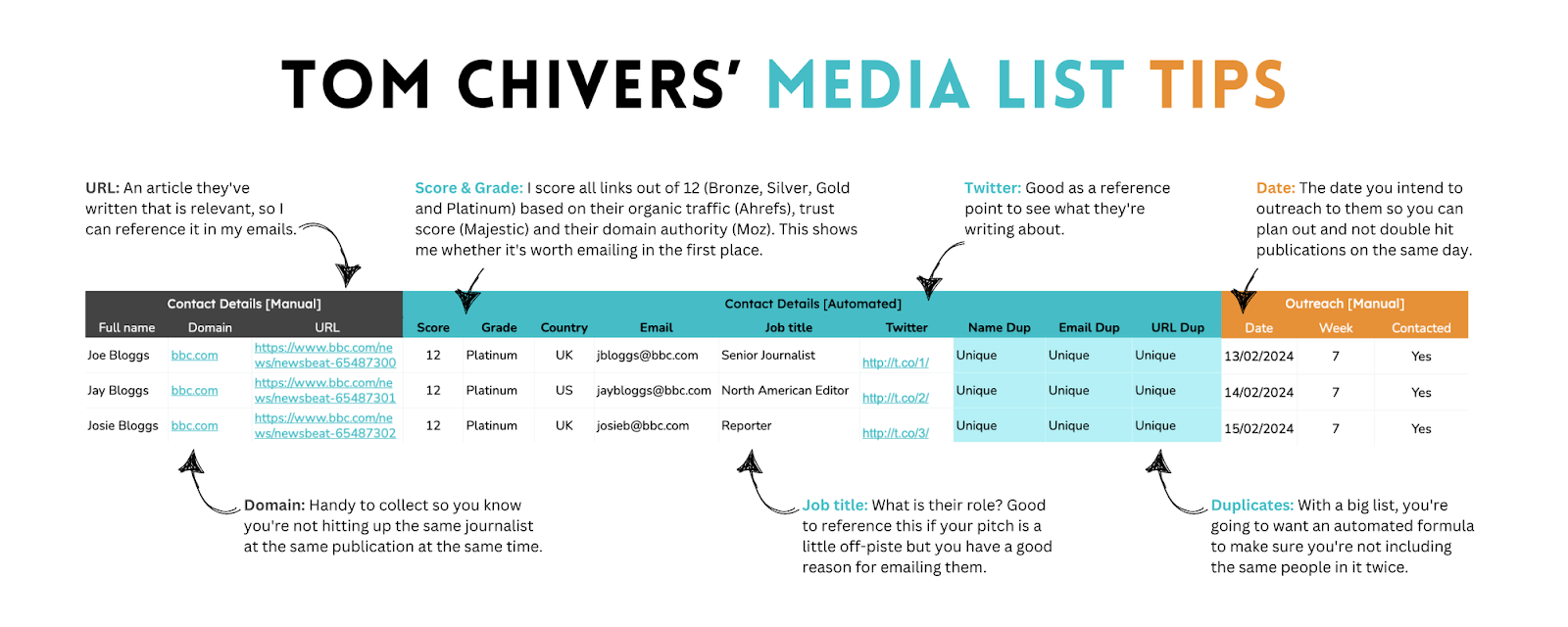
In my campaign seeding lists, everything except Full Name, Domain, and URL is automated from a master seeding list I have created. This is basically just a massive database of every journalist I've encountered because you're never going to be able to find EVERY journalist on some platforms, so it makes sense to build your own. All I have to do is input a journo's first name, and the domain they write for, and the rest of the information is pulled in from a massive database of over 70k contacts – that's if I already have them – if I don't, I need to get digging!”
Tom Chivers, PR Expert and founder of Sabot
Pavithra Sekar
Before creating the list, I usually go back to my Questions board and try to understand the exercise better. Some of my favorite questions,
- Is this a one-off list or an ongoing inventory?
- What is the goal of this campaign?
- Are we looking at any specific regions, etc.?
Once I have some information, I curate the list with the following details,
- Reporter name
- Job title
- Media company
- Region
- Do they contribute to other publications? If yes, list them in the contributing field
- Area of focus (the beats they usually cover)
- Recent post/article (one or two links)
- Competitor story (if they've covered any of the clients' competitors)
- Social media links (LI, Twitter, Instagram with follower count)
- Status (did we contact them earlier, is it a new contact, did they reject our proposal earlier, etc)
- Quick overview (my absolute fave field → a quick study of the reporter's preference, work nature, and thoughts)
- Finally, the checklist (strategy to be used, timeline, Single Point Of Contact [SPOC], medium, etc)
Senior Community Engagement Specialist, Kissflow
Buying vs Building a PR Media List
You can buy pre-built media lists from vendors, but often these paid lists are:
Expensive
Out of date
Irrelevant to your campaign
Media list building takes time and effort, but it allows you to tailor the list to your specific goals. It also gives you confidence to know that you’re pitching not only the right reporters, but the ones who are active at the point of pitching.
The perceived benefit of paying for a media list is the time it can save you. But from personal experience, I haven’t seen that being the case. I have been shared on a – not necessarily paid – but pre-built media list for my own niche. At the time I thought: “Great. I can get on and start pitching.” But when I began writing those pitches, I quickly realized that the list wasn’t quite right. It might sound like a no-brainer, but journalists with the same overarching beats have very different styles of writing and stories to tell. And it took me assessing every individual journalist on the list to work out that none of them would care what I had to say.
The extra time it took me to validate could have been better spent on researching the right journalists that would care, from the get-go. Instead, I’d lost hours and was back to square one. Some PR pros in my position might still have gone ahead and pitched regardless, but that kind of approach goes hand in hand with old-school, spammy “Spray and pray” PR tactics.
According to our State of the Media report, journalists say the number one thing they need to see from a comms professional is relevance – specifically, 74% say they'd like PR professionals to understand their target audiences and what they find relevant.

Download the report for more insights into what journalists want from PRs.
Tayla Davie
“Relevancy is arguably the most important factor to consider. Always source contacts who cover topics closely related to your pitch or campaign. Prioritize contacts who have engaged with your brand or content in the past, have a track record for responding to pitches, or contacts you’ve established relationships or rapport with. As the imbalance between the number of PRs to journalists continues to grow, creating a super targeted media list has become more important than ever – the ‘spray and pray’ method won’t cut it.”
If you want to get quality coverage, you need to forensically research your target journalists, and invest time in building unique, tailored media lists. Buying generic journalist lists won’t cut it in 2024.
How to Build a Media List in 5 Steps
So, how do you create a press list? We've got the answers. Follow these five steps, and you’ll have all the ingredients to create a winning PR campaign.
1. Get to Know Your Audience
The aim of any PR pro’s game is to get in front of potential customers. But before you can work out which press they're consuming, you need to know who they are. Just like any other content strategy, you should start off by trying to get inside the mind of your audience.
Find the social platforms they congregate on
Find the communities they engage in
Find the topics they care about
Find out what they search
Find out which publications they read
A great tool I use for this is SparkToro...
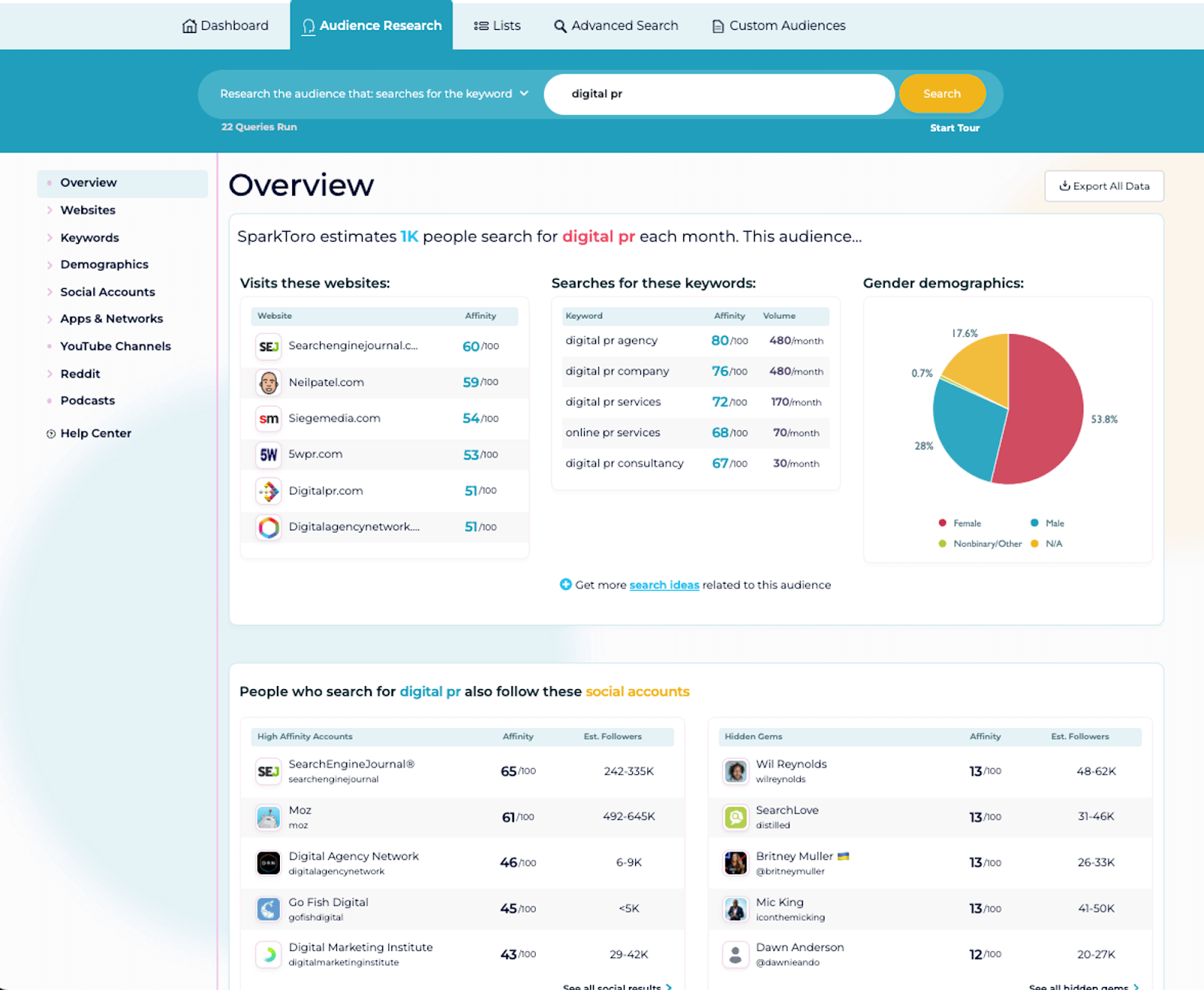
Once you know exactly who your audience is, you can begin to discover the types of content and publications they’re most interested in. Then, all that's left to do is find the journalists creating that content and add them to your PR media list.
2. Decide What to Include Based on Your Goals
Earlier on in this article we looked at the key information to include in your press list – but no two brands share the same goals. And for that reason, no two media lists should be the same. To help a journalist tell a story they want to tell, while also being mindful of your own goals, you need to add extra detail to your media list.
Do you have global coverage targets? Then you’ll probably be pitching journalists in different time zones. Adding local times to your media list will help you pitch individual journalists at the right time for them. Or maybe you’re going to measure your PR by reach. If so, prioritize journalists who drive the highest potential audience reach for your campaign's topic.
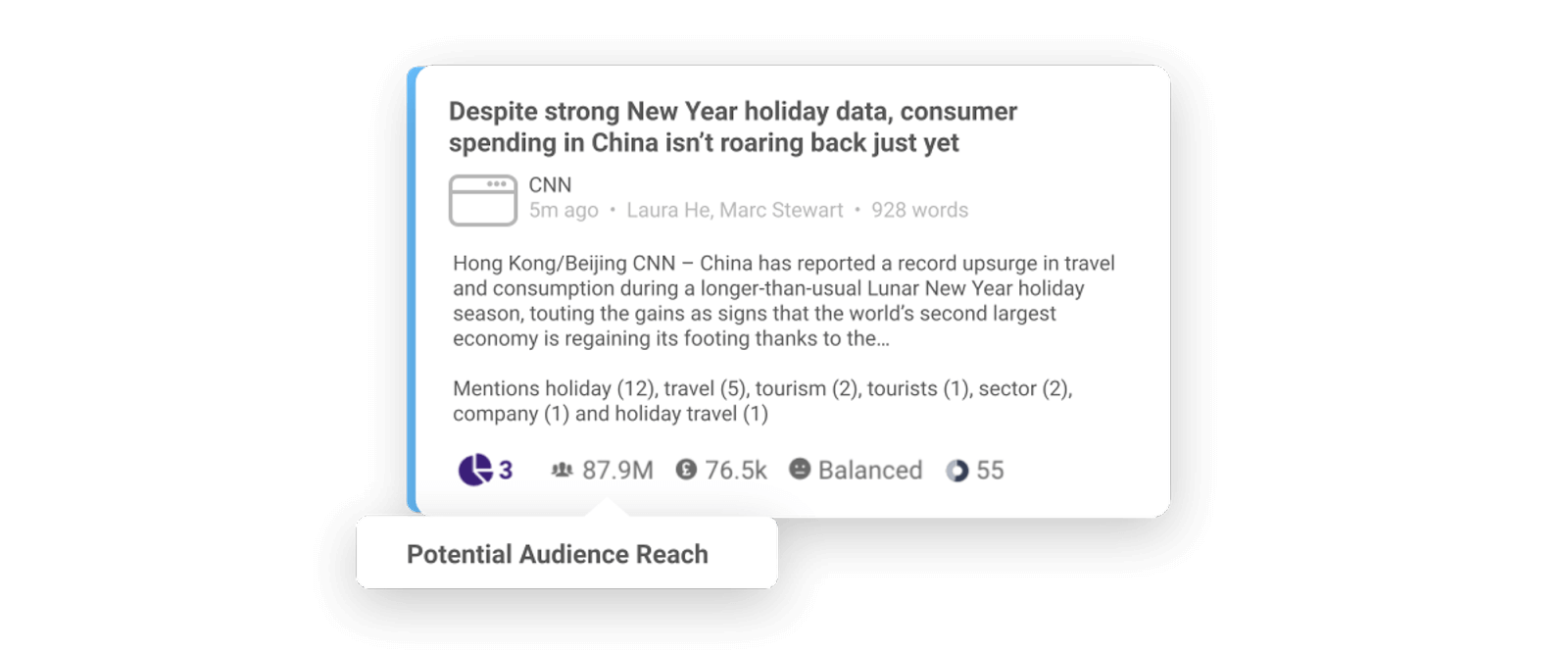
A mention in CisionOne showing Potential Audience Reach score of a piece of journalist content. Based on traffic data from SimilarWeb.
This might seem like quite a “you-centric” way of building a media list, but knowing this information will also please journalists. Take the examples above. Emailing journalists at a time when they’re most receptive will be appreciated. Emailing them after work hours? Maybe not so much. And giving journalists fresh angles on their most-read stories? I don’t know any journalist who would take issue with that.
3. Find and Add the Journalists Who Are Right for You
Now it’s time to source the journalists who are most likely to snap up your story and push it out to the widest audience. You can do this in any number of ways, but here are some actionable tips to get you started.
Use Social Media Platforms

Use X to search journalist job titles and connect with those already on the fringes of your network. You can also find journalists via the hashtags #journorequest, #journalistrequest, or #PRrequest – to make your search more relevant just append a campaign-specific keyword. And don’t forget LinkedIn. Search a journalist related job title to find writers in your immediate network – including first-, second-, and third-tier connections. These people are likely to pen content relevant to your industry.
Use a Media Database
Media databases are a central source of journalist information and contact details. They make finding journalists easy – saving you hours of legwork. CisionOne's media database is one of the most thorough out there, containing over 850 thousand up-to-date journalist profiles.

To give it a spin, speak to an expert.
Use Google News
Find journalists who accept expert commentary via Google News by searching “according to” then add your “keyword” topic.

Tricia Harte Miller
“Google News can be a great source of inspiration when building reactive media lists. If we’re trying to newsjack a certain headline, we’ll use Google News to see which specific journalists and publications are talking about it and put together a list from there. We’ll also use tools like Cision’s “talking about” feature to quickly put together media lists of people who are mentioning a trending word or phrase. Whichever route you take, making sure you’re finding those journalists quickly and sending your media lists out with a “here’s how we can continue to further this topic in the news cycle” pitch can go a long way.”
Tricia Harte Miller, Director of Digital PR and former journalist, Digital Third Coast
Use Ahrefs’ Linking Authors Report
Ahrefs recently released a new tool which allows you to find individual authors and journalists linking to a specific piece of content. As Digital Loft’s PR Director, Amy Irvine, points out, this is a brilliant way to reverse-engineer relevant journalist contacts from competitors.
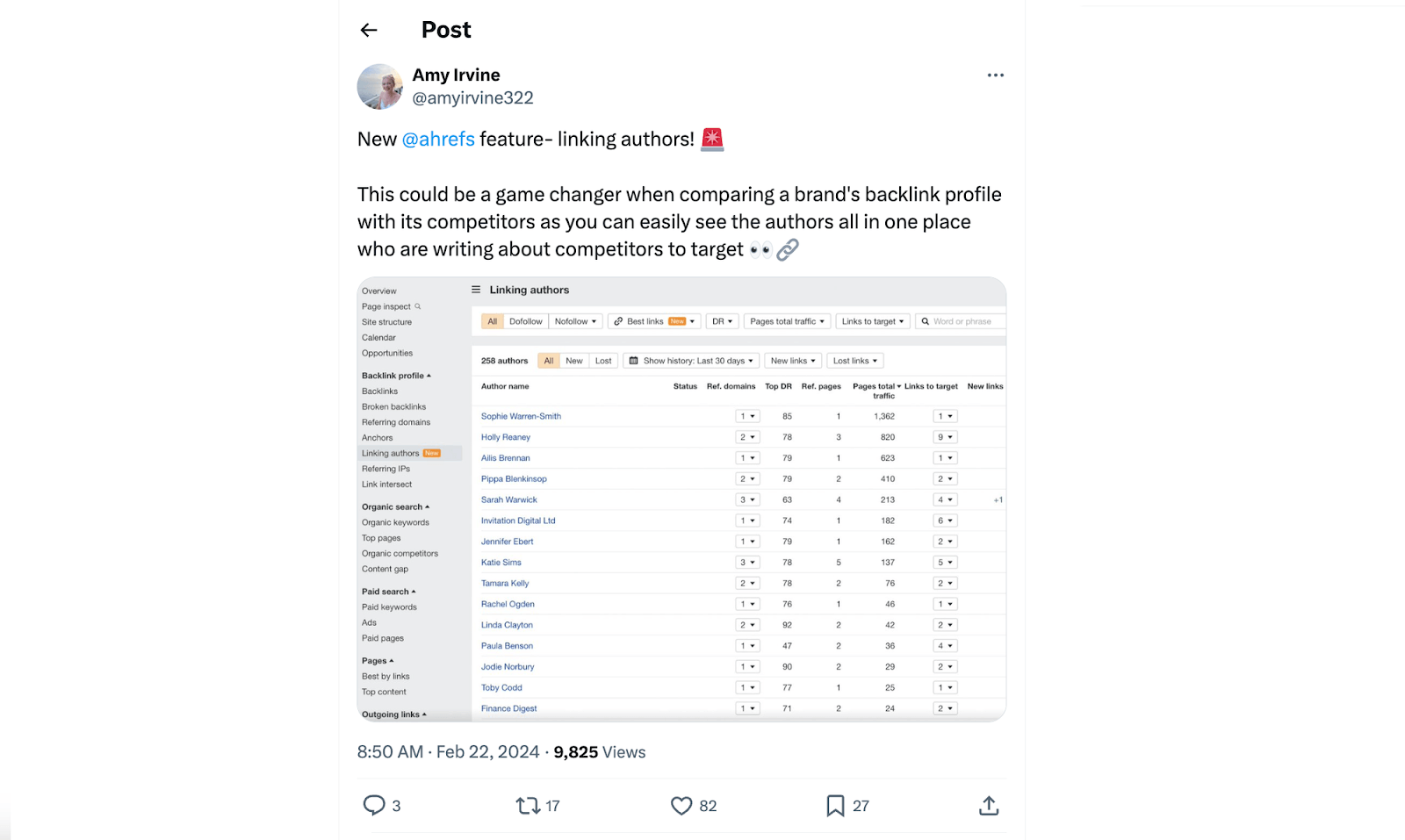
Track Competitor Press
When it comes to finding journalists through your competitors, it pays to be proactive. Monitor their coverage as soon as it comes in, by setting up a Google Alert or a CisionOne mention stream on their brand name.
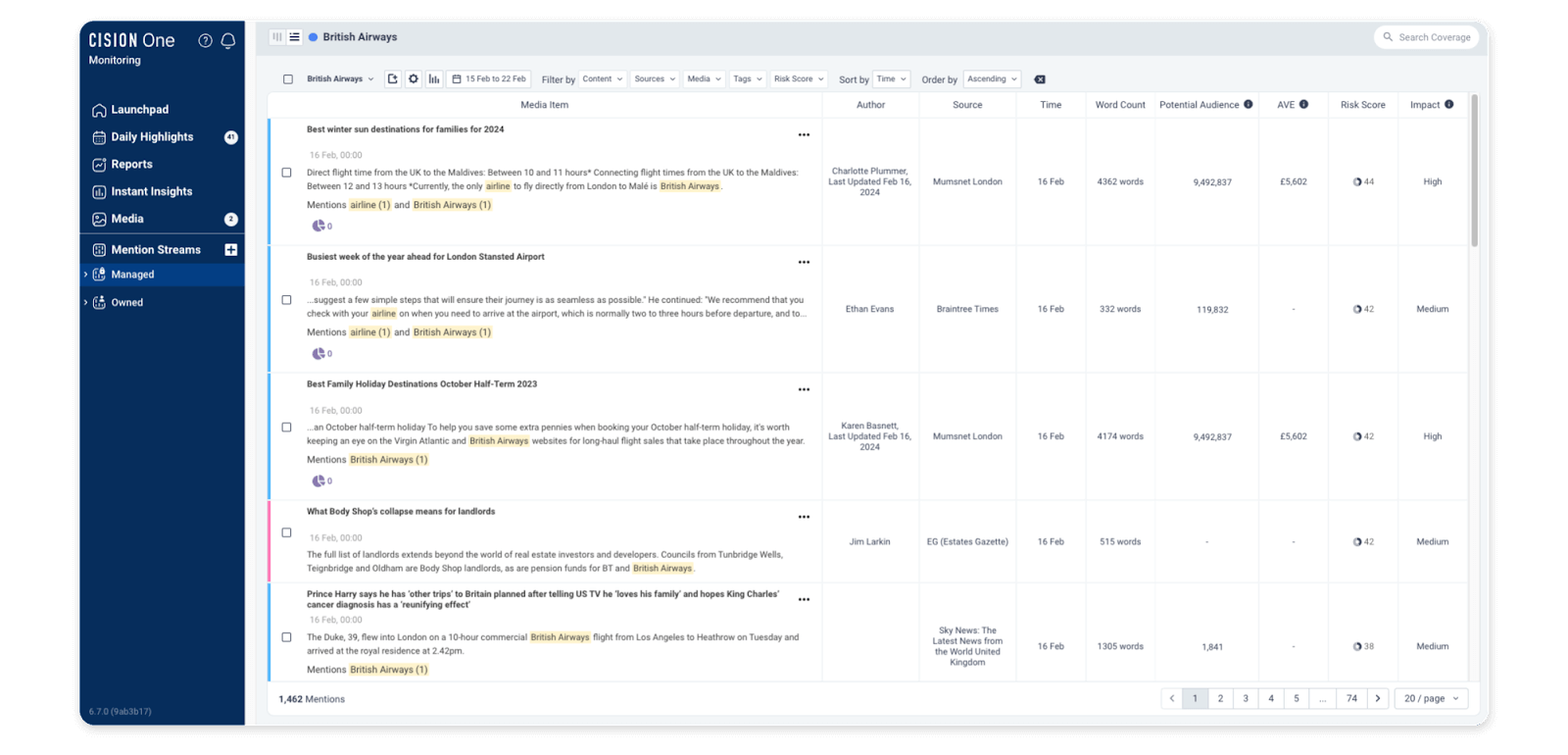
Scour Author Profiles & Contact Pages
If you already have a publication in your back pocket, Google them and track down editors to pitch via their author profiles or contact pages. The Guardian, for example, has a page dedicated to pitching advice.

Alternatively, just search the publication in a database.
4. Pick the Format, Layout, and Tool
Once you've decided which details to include in your media list, it's time to think about how you're going to record all that information. Most PR pros use the humble spreadsheet to build their media lists.
Spreadsheets (e.g. Google Sheets)
Spreadsheets aren't a bad solution; however, at risk of stating the obvious, they're static documents. Unless you've configured some sort of integration wizardry via Zapier or ITTT to automate your press list, updating a spreadsheet can be a long slog of a process, since it relies on your manual input to keep it ticking over.
Even if you've managed to create a seriously impressive, automated media list (and kudos to you. You are a better data wrangler than I!), it still might not be the best solution for collaboration and workflow management.
Pros of a spreadsheet-based media list
Low/no cost. Usually everyone can access a spreadsheet with no add-on fee.
Easy to access. Again, few barriers to entry – even when working offline.
Easy to customize: Journalist details, data, filters, graphs, and calculations can be customized. Google Sheets can plug-in to other data sources for extra customization if needed.
Cons of a spreadsheet-based media list
Timely to update. Usually a manual process to build and pull in data from different sources.
Vague audit trail. Tricky to track who made what changes to certain contacts over time and not always possible to see contact history.
Collaboration headaches. With multiple editors, coordination and communication becomes difficult – especially if notifications don't push through when changes get made.
Prone to human error. Mistakes can easily be introduced and go undetected.
Scaling problems. Performance slowdowns and formatting issues as the amount of data and users grow.
If you want somewhere to not only build your media list, but research, discover, and outreach to journalists in one place, a media database or PR CRM might be right for you.
Workflow Tools (e.g. Airtable)
Workflow tools like Airtable and Asana will help you record your media list criteria and assign it to specific campaigns. You can upload all your campaign/pitch assets to the system, build your coverage into visual calendars, and work collaboratively to push through status updates on your PR activity. The main drawback of workflow tools is that you are unable to outreach to journalists from within the platform, and will need to build complex integrations to be able to report on outreach in a workflow tool.
Digital PR Platforms (e.g. CisionOne)
Using a digital PR platform to build out your media list can help you avoid a lot of the headaches a spreadsheet creates. A media relations tool like CisionOne is:
Fully compliant, with contact data that follows strict privacy protocols.
Self-cleaning and auto-updating so that your media list stays forever fresh.
Collaborative, so you can keep track of team comms and pitching progress.

Comprehensive, helping you find the right journalists and saving you time on sourcing contact details or social media profiles.
Integrated with email performance data, so you can build your press lists into your workflow and analyze their effectiveness.
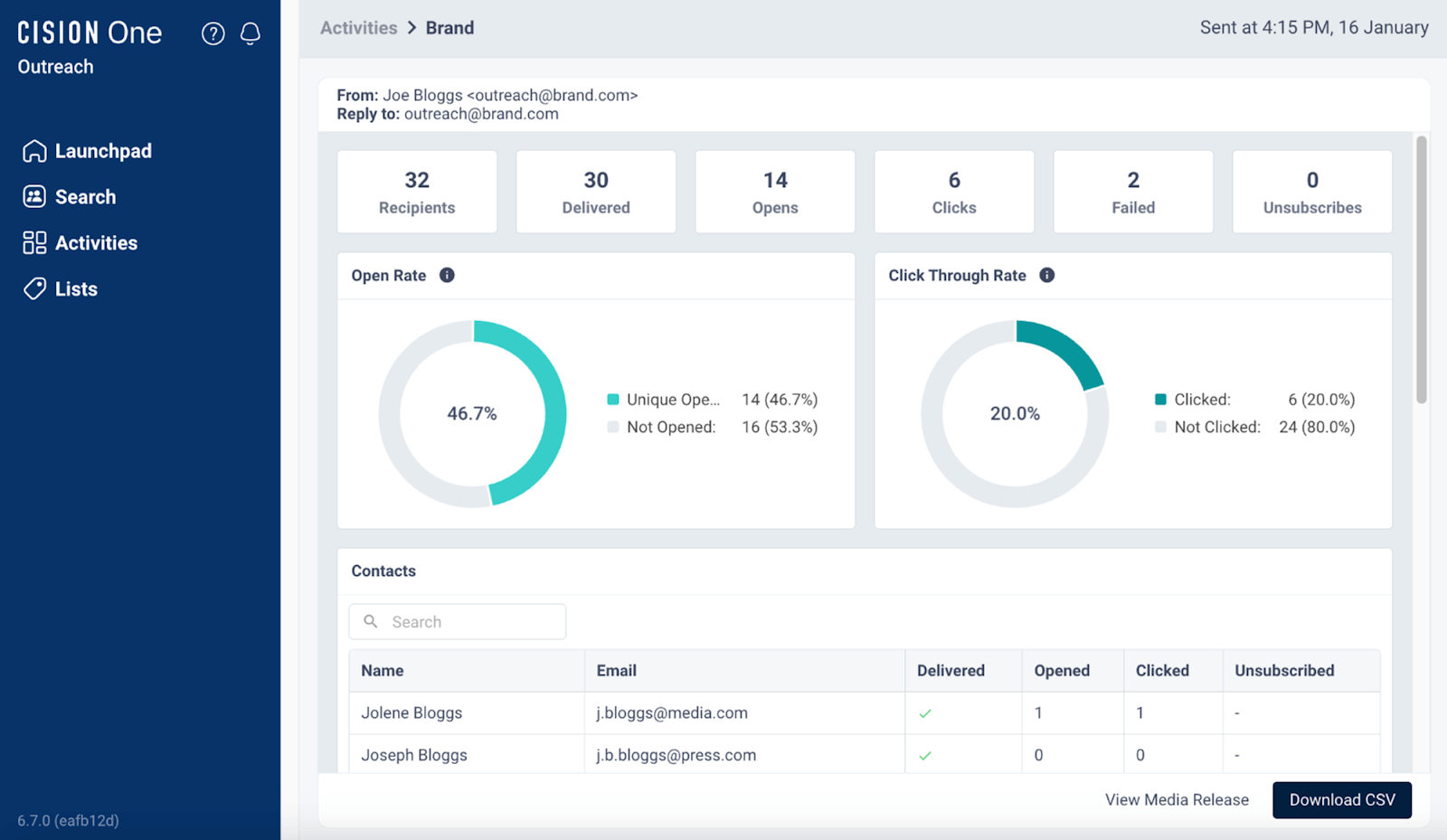
Easy to scale allowing you to build as many custom media lists as you need to for your brand or clients.
5. Keep Your Media List Up to Date
Here’s why you need to make sure your list is permanently updated:
Journalists move around: Given the economy, journalist turnover is high, personnel changes are rife, and editorial teams are leaner than ever. You need to have the right contact details and know who is active at the point of pitching.
Journalists change beats: As mentioned, teams are leaner. Journalists – both in-house and freelance – are having to pick up multiple beats, and these can change from one day to the next.
New journalists enter the market: It’s not all doom and gloom. Publications regularly hire newly qualified journalists. Contacting new journalists via an up-to-date seeding list will give you a great opportunity to build a long-term relationship.
If you don’t keep on top of active journalists, you risk wasting time researching and pitching dormant inboxes, or irritating journalists who no longer cover your topic. So, how do you know if a journalist is still active?
Keep a Close Eye on Their Latest Content
If you keep one eye on a journalist’s recent content, you can make a better call on whether they’re likely to see and respond to your pitch. If they’re getting published frequently, for example, then you’re probably safe to keep them on your media list. Knowing what they’ve recently published can also prevent common PR faux pas, like pitching them the story they’ve just written.
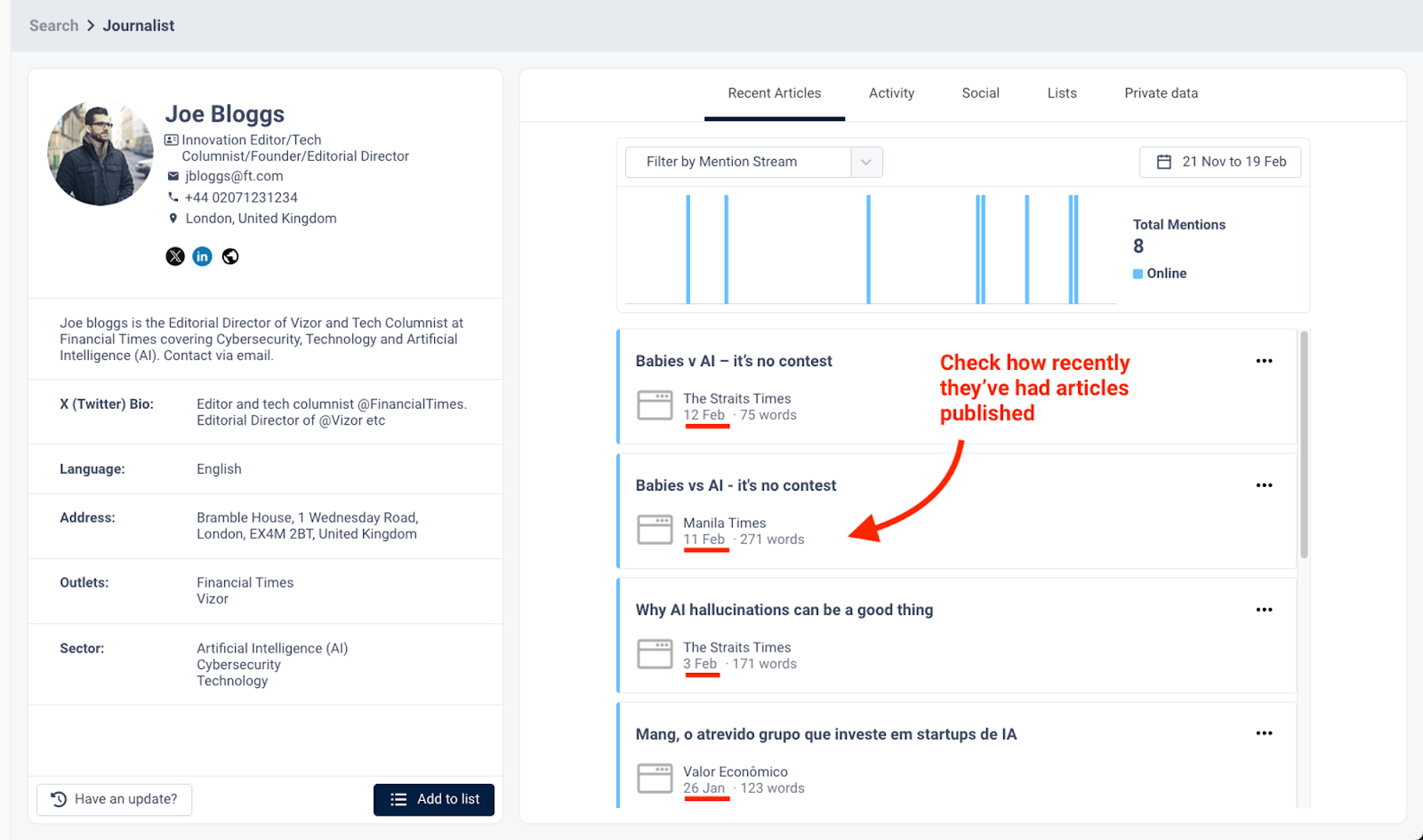
Follow Their Social Activity
Many journalists are active on social media, and their posts can be a good clue as to what they want from a pitch, as well as what they’re working on. Some will even notify PR pros of their role or beat changes and welcome new connections – or even pitches. If you have their social profiles on hand in your media list, then you can do a quick check to verify that a journalist is active.
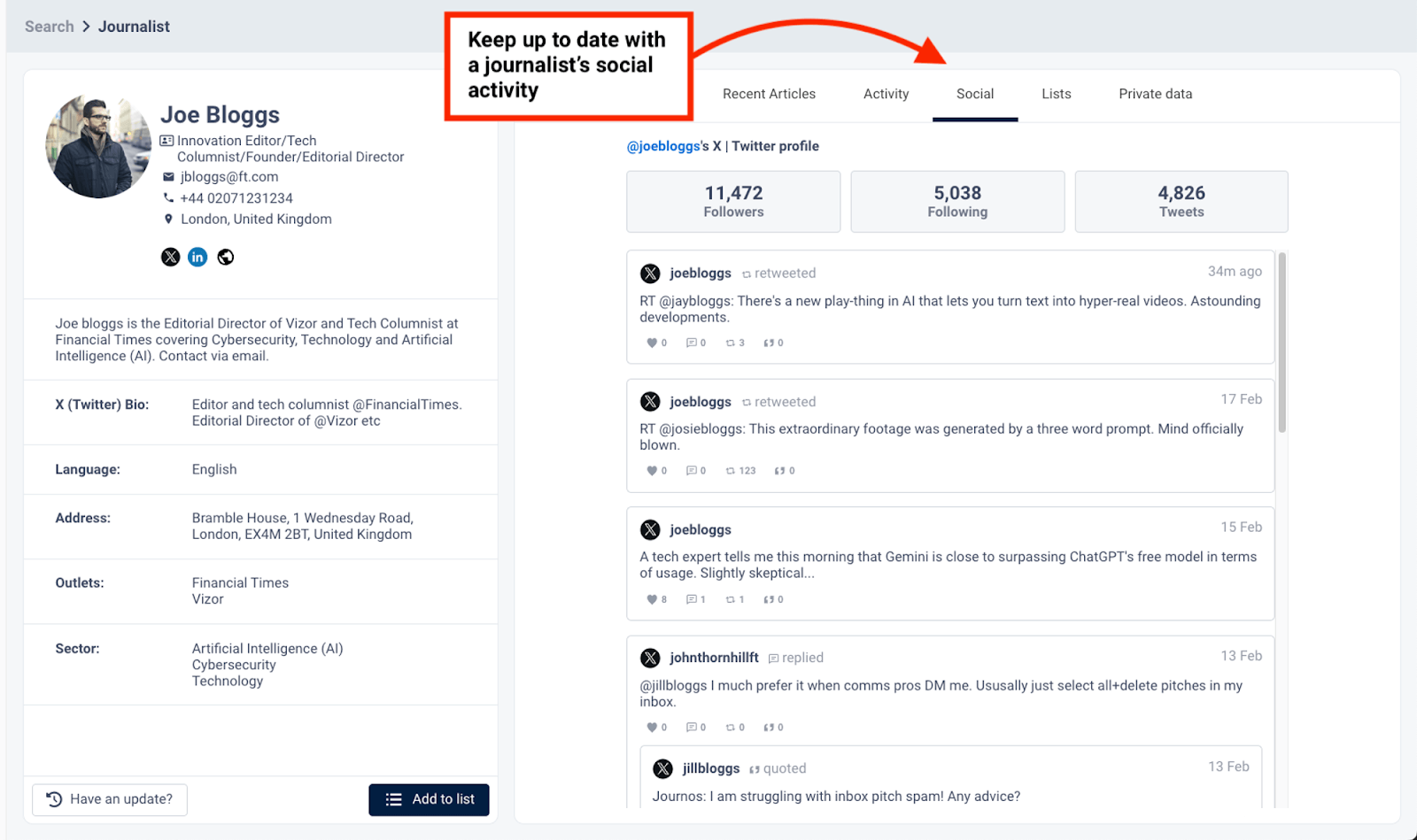
Record OOOs and Bounce Backs
Paying attention to any form of bounce back will be important in keeping your media list fresh. Often bounce backs will refer you to another journalist. Consider if this person would make a relevant contact for your media list.
How To Prioritize & Schedule Your Media List Outreach
1. Group Contacts by Angle, Vertical, or Niche
At risk of sounding like a broken record, pitching is all about relevance. You’re bound to have different angles for the same campaign, so grouping your contacts together based on the angle that’s most relevant to them is a savvy way to prepare your outreach. Katy Powell from Bottled Imagination groups contacts by niche within the broader industry, to better tie pitching angles directly to what journalists cover (e.g. separating lifestyle from health journalists).
2. Grade Publications and Journalists
Pitching isn’t quick, and it sure ain’t easy, so you want to make sure you’re getting the most mileage out of your coverage. One way to do that is by using certain metrics to validate the performance of journalists and publications. Tom Chivers, PR expert and founder of Sabot, does just this. He scores media outlets out of 12, and awards them Bronze, Silver, Gold or Platinum based on their:
He then uses this to determine whether it's worth outreaching to the journalists that write for said publication. Using a scoring system like this can help you bump high performing contacts to the top of your list.
3. Batch Outreach Based on Press Potential
Once you’ve grouped by angle and filtered out low grade contacts, it’s time to batch up your outreach. Here’s an example of how Iona Townsley, Founder of Heroine PR, does just that:
"I GROUP JOURNALISTS TOGETHER INTO SCHEDULES (IE. WAVE 1,2,3,4, ETC) DEPENDING ON WHO I THINK IS MOST LIKELY TO COVER IT, SO I'M NOT BOMBARDING JOURNOS AT THE SAME PUBLICATION.”
Katy Powell from Bottled Imagination prioritizes contacting major publications first, then works her way down to niche publications.
4. Schedule by Location, Time, and Date
The last factor you need to consider is the best time and date for your media contact to receive your pitch. Separating out your media contact list by location is wise, not only because countries operate on different times, but because their calendar year looks very different. This can help you avoid pitching empty inboxes on national holidays, for instance.
Iona Townsley slices and dices her media contact list further based on their time zone and location:
“DURING THE SEED LIST STAGE I ALWAYS ADD THE TIME I NEED TO OUTREACH TO JOURNALISTS, AS I OFTEN DO INTERNATIONAL OUTREACH AND LIVE INTERNATIONALLY MYSELF, SO IT HELPS KEEP ME ORGANIZED."
Behind Every Successful Media List Is a Strong Network
Look around you. Who makes up your network? A journalist today isn’t an op-ed writing gal-about-town who pens one column, breaks the internet, and spends the rest of the month drinking dry martinis. Yes, we’ve been sold a glamorous lie. What I'm getting at is that journalists aren’t totally unrelatable or unreachable. It’s easy to put them on a pedestal given the power they wield over your PR, but the reality is they need you.
Whether they’re freelancers scrabbling for stories to land their next gig, or staff writers in desperate need of content to cover the three extra beats they’ve been thrown since the last round of layoffs, journalists today need all the help they can get.
And since they’re not the minor starlets Hollywood would have us think, but in fact mere mortals like you and I, it's entirely possible you’re already connected with a few. Review your existing network, ask friends for introductions, and remember to put yourself out there – if you have expertise to share, make sure journalists see it. Don’t just connect and then wish upon a star – or even worse, bombard them with pitches. Play a longer game. Post your wisdom and relevant campaign content on social. Start a newsletter of your coverage and PR hot takes. Give journalists a reason to trust, respect, and want to work with you.
How To Manage Your Media List
- Manually update: Tweak your media list as and when you find new information on your chosen journalists.
- Automate: Use data integrations or v-lookup to automate your own, bespoke process of updating your media list.
- Use a Media Database: Opt for a PR tool that uses AI and human-validation to clean and update media profiles.
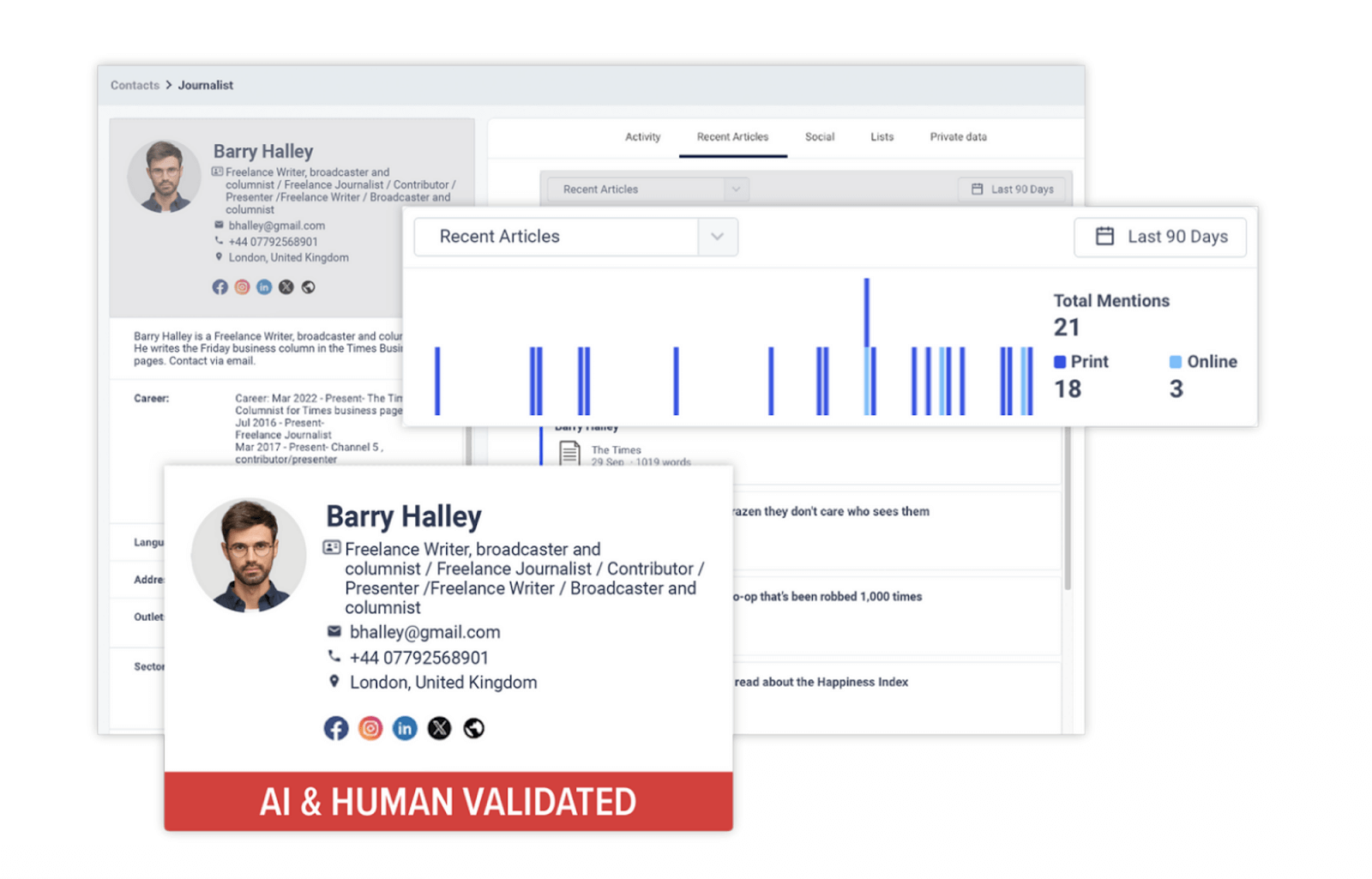
We've built CisionOne to be a living, breathing index of forever-up-to-date contacts AND content. Using groundbreaking AI and a team of 120+ global researchers, we push through 20k journalist profile updates a day – including bio and contact information, topics, engagement metrics, and recent content. If you create your media list within this database, you’ll always be pitching relevant and fresh contacts.
Should You Share Media Lists with Clients?
The thought of sharing a media list has the ability to strike fear in the heart of any PR pro. These lists represent years of hard work in building relationships with key media contacts, so it's understandable that PR's want to hold on to them with a vice-like grip. But on the other hand, being transparent and collaborative with clients can lead to great things.
I stumbled on a seriously interesting thread about just this in the SpinSucks community, founded by the awesome Gini Dietrich. If you're not already part of it – go join! It's 100% free.
Based on a discussion between a number of PR experts, here are the pros, cons, and best practice tips for sharing your media lists.
Pros of sharing media lists:
- Builds trust and transparency with your client
- Allows your client to provide input and suggestions on contacts
- Educates your client on your strategy behind media targeting
- Reinforces your agency's strategic value beyond just the contacts
- Clients are less likely to badmouth you if they transition their outreach in-house
Cons of sharing media lists:
- There's a risk your clients go behind your agency's back to pitch contacts directly
- Could damage hard-earned relationships if your client spams journalists
- Your client might micromanage or question every media contact
- Reveals proprietary information you have built over the years
Best practice advice:
- Gauge your client's motives before sharing
- Only share outlet names/spokespersons, not personal contacts
- Provide context on each contact's interests and dependencies
- Make it clear your relationships are your value-add
- Have an upfront conversation about using the list appropriately
- If your client misuses the list, revoke access and re-evaluate the relationship
Be open, educate your client, and define clear guidelines from the beginning. And, remember, if trust is low, protect your journalist relationships. Judge wisely and on a case-by-case basis.
A well-researched and targeted media list is invaluable for securing quality media coverage. By taking the time to deeply understand your audience and the journalists who appeal to them, you can create pitches that inspire journalists to cover your story.
Keep your list organized with all the relevant details like topics covered, past articles, preferences, and performance metrics. Regularly update the list as journalists change beats or publications. Tools like media databases can help streamline the process.
To try out CisionOne, speak to an expert for more details.







